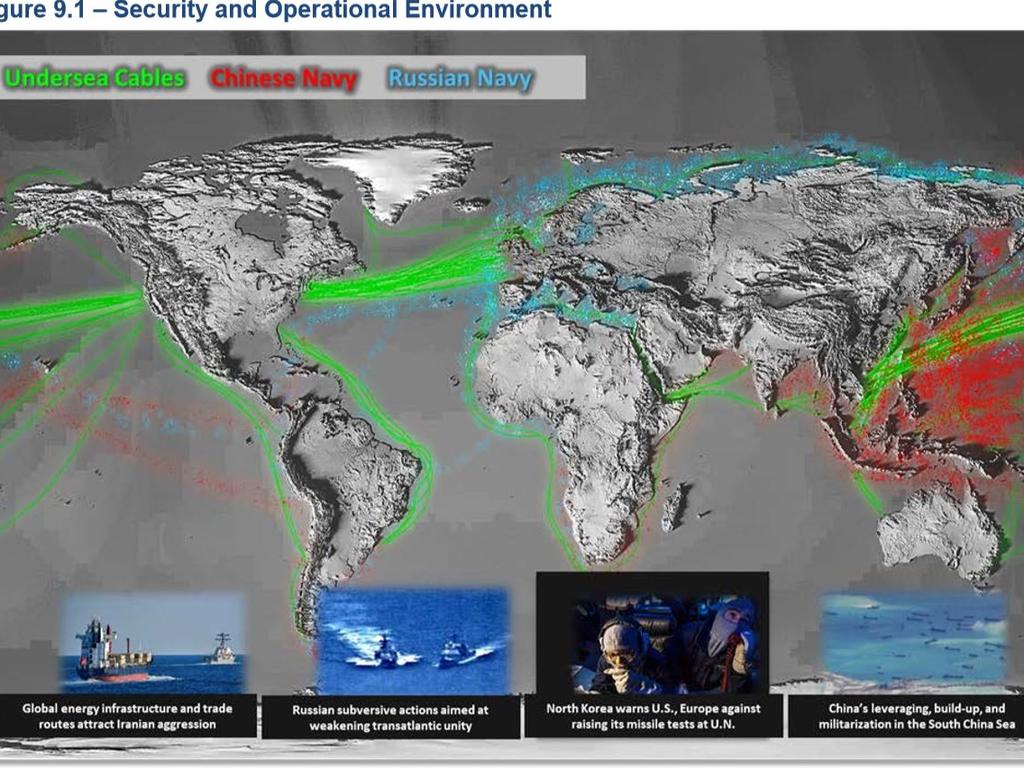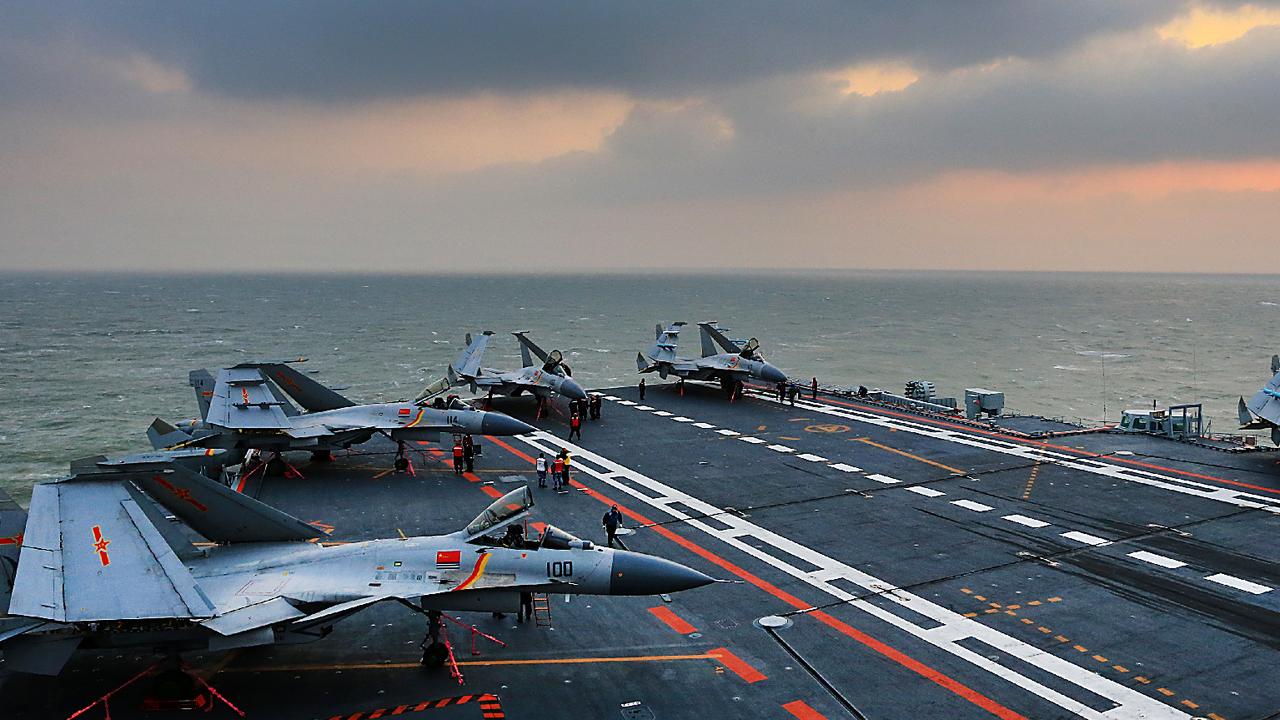Experts warn of China’s growing offensive capability
A newly released map tracking naval activity proves Beijing’s moving to dominate the Western Pacific – and Australia falls within their reach.
If ever there was any doubt about China’s growing military reach, this map dispels it all.
In its argument for extra cash from the US Budget, the Pentagon has released a summary of Chinese and Russian naval activity.
It intended to alert politicians to the challenge US forces now faced. It locates patrols by warships and submarines – red for China, blue for Russia. Highlighted in green are the undersea cables vital for international communications.
Now, a senior US Admiral warns that Chinese and Russian submarine activity meant even the US East Coast was no longer “uncontested” or a “safe haven”.
But it is the broad swath of red in the Indo-Pacific that has serious implications for Australia.
It shows Beijing is serious in its ambition to dominate the Western Pacific.
And Australia falls well within its proposed lines of control.
RELATED: The West has badly underestimated China
RELATED: Analysis states Beijing could win regional war against US

Lowy Institute director Sam Roggeveen argues there are “good reasons to think that the US lacks the political will to stage a full-scale strategic contest with China”.
“For Beijing, on the other hand, the motivations are obvious: no nation of its economic rank will want to remain a second-rate strategic power in its own region,” he writes.
Senior colonel of China’s People’s Liberation Army (PLA) Zhou Bo recently defined this contest of wills in a New York Times editorial: “America thinks that China wants to drive it out of the region; China believes America wants to block its legitimate ambition to develop a bluewater navy and hopes instead to confine China’s influence to the eastern coast of continental Asia.”
Who is most determined?
Roggeveen states: “The two key questions for America’s allies in Asia are how long do they want to maintain a US-centred strategic posture, and when do they start preparing for a post-American future?”
But commander of the US Indo-Pacific Command, Admiral Philip Davidson, told the Lowy Institute Thursday that the United States “was all in” to counter China in the Pacific.
INK ON PAPER
The Pentagon map is included in its FY2021 Defense Budget Overview.
We don’t know what time frame it covers. We don’t know what kind of activity it records. What we do know is it was presented in the context of emerging threats and growing “great power competition”.
“We continue to see increased reliance on the maritime system, with maritime traffic increasing fourfold over the last two decades,” the report reads.
Some 90 per cent of the world’s trade is carried by ships, it notes.
And new shipping lanes are opening as the Arctic ice to the north of Russia and Canada retreats.
But tankers, container ships and freighters aren’t the only concern.
“Almost the entire internet and trillions of dollars in trade are carried today on a largely unsecure network of undersea cables.”
But, closer to home, the map appears to confirm Beijing’s determination to dominate the Western Pacific.
Those red dots, analysts argue, are concrete evidence of Beijing’s adoption of a global military posture. Little more than a decade ago, China’s navy did not have such a reach.
But, now, it is demonstrating to the world that it can influence maritime activity out to what it calls the “Third Island Chain” – its side of the entire Pacific Ocean.
“An ever-rising China can only be more determined to safeguard what it sees as its sovereign rights,” Zhou argues, “especially when Washington has deliberately intensified its competition with Beijing, and rather aggressively.”
At the heart of the issue, however, is the legitimacy of those claimed sovereign rites.
Admiral Davidson, who was visiting Australia for talks with Prime Minister Scott Morrison, yesterday accused Beijing of “excessive territorial claims, debt trap diplomacy, violations of international agreements, theft of international property, military intimidation and outright corruption”.
BOUND IN CHAINS
In recent decades, China’s military has envisaged three geographic perimeters in the Pacific.
It has already all but secured the “First Island Chain”, being the South and East China Seas encompassed by the Kurile Islands, Japan, the Ryukyu Islands, Taiwan, the Philippines, Borneo, Malaysia and Indonesia. In some versions, it continues through Indonesia, the Indian Ocean’s Marianas out to the British-US base of Diego Garcea.
Essentially, this secures China’s vital sea lines-of-communication with the oilfields of the Middle East.
The “Second Island Chain” is a rough boundary linking Japan’s Ogasawara Islands, the Mariana Islands (which includes the US military base on Guam), Micronesia, Palau down to Indonesian West Papua.
A “Third Island Chain” divides the Pacific in half between the US and China – running a line south from the Aleutian Islands and Hawaii through the Caroline Islands down to Tonga and New Zealand.
Australia falls well within this embrace.
But the map reveals an unexpected area of PLAN activity: the Chukchi Sea. This is an entry point to the Arctic just north of the Bering Strait between Russia and Alaska.
A northern passage through the Arctic Sea would dramatically shorten shipping trade links to Europe. So is Beijing’s getting in early to establish control over this potential new maritime chokepoint?
The Pentagon budget report reveals the stress it is feeling: “We simply have a lot more to protect from increasingly capable maritime adversaries who will present challenges to our economic security and indeed, our very way of life.”
Admiral Davidson went further.
“The Communist Party of China seeks to control the flow of trade, finance, communications, politics and the way of life in the Indo-Pacific,” he told the Sydney gathering.
TIGHTENING THE NOOSE
The Pentagon’s map demonstrates Beijing’s commitment to its expansive strategy.
Analysts argue China is building up its massive intermediate-range missile arsenal to prevent opposing naval fleets from entering the Western Pacific. This will be supported by cruise-missile carrying bombers operating from South China Sea island fortresses. And its attack submarines will exploit new-found knowledge of the Pacific sea floor.
Strategic analysts also believe China is building up its aircraft carrier force to impose its reach out to the Second Island Chain.
The PLAN’s second aircraft carrier (the first it has built itself), the Shandong, entered service earlier this year. It has already joined the Liaoning in projecting China’s presence into the Pacific, past Taiwan and the Philippines.
But these ships, and possibly a third already well under construction, represent just the first step in Beijing’s plans. It wants much larger nuclear-powered aircraft carriers to enter service in the 2030s. With these, controlling the Western Pacific all the way out to the Third Island Chain will become a much more viable notion.
It’s something the Pentagon is well aware of.
“Their single aspiration is to elevate their own status and capacity on a global scale,” deputy assistant secretary of defence Chad Sbragia told the US government late last year. “What it does mean is that they will have the global military where the US essentially may have no safe harbours.”
And that goes beyond the US.
“It will not look like it did in the past. We will have to move across a space (that) could be contested both for ourselves and our allies from the start and in all domains,” Sbragia said.
Admiral Davidson says Australia is already feeling the impact: “Beijing has showed a willingness to intervene in free markets and hurt Australian companies simply because the Australian government has exercised its sovereign right to exercise its national security”.

TIPPING THE BALANCE
The Lowy Institute’s Sam Roggeveen says Australia has enjoyed an “extended holiday from having to think about serious threats” under the protective umbrella of the US since the end of World War II.
No more.
But that doesn’t necessarily mean war, he says.
“China can’t do today what the US did in the 19th and 20th centuries since the US and several regional great powers will constrain its behaviour,” he says. “As China commentator Tanner Greer puts it, ‘Beijing is well aware that if it decided to do to Tonga now what the United States did to Hawaii more than a century ago, it would mean war’.”
Zhao says the China-United States relationship is generally stable, “but we are confronted with many difficulties and challenges.”
“Officials in Washington and other Western capitals have expressed dismay that China hasn’t become more like the United States, or at least more democratic. But did China ever pledge to become like the United States? And so what if it hasn’t become that? Competitive coexistence is still possible.”
Roggeveen argues the US has been no paragon of virtue. Its repeated support for authoritarian governments has seriously undermined the legitimacy of its authority.
“None of this is to argue that a Chinese-led order in Asia would be preferable than the current arrangement,” Roggeveen says. “It is only to point out that the transition may be less brutal than we imagine because to a large degree, great powers all act alike.
“And yes, there will be a transition, because what will ultimately decide the question of strategic leadership in Asia is not whose model of leadership is more attractive, but which of the two competitors is prepared to take the biggest risks, and make the biggest sacrifices, to secure leadership.”
Jamie Seidel is a freelance writer | @JamieSeidel



